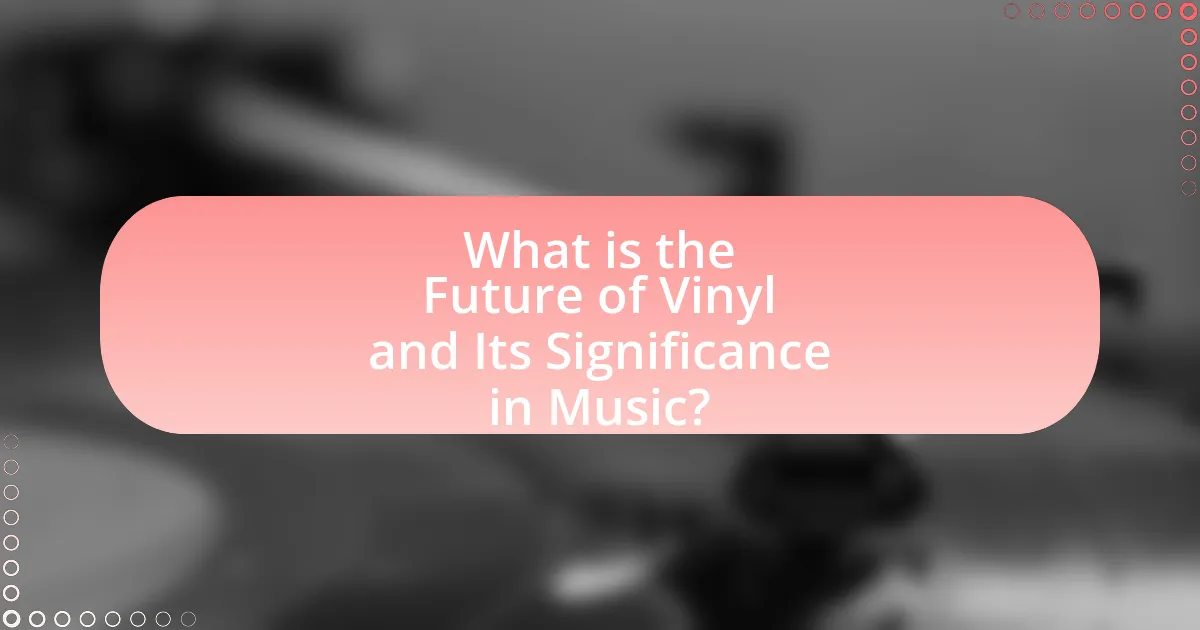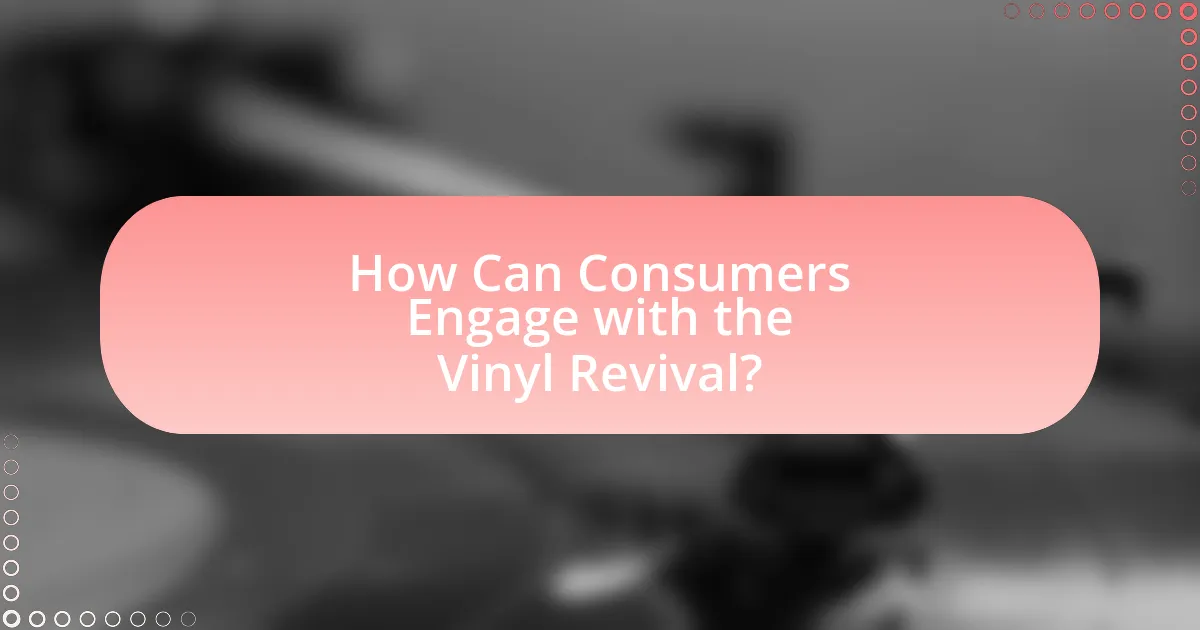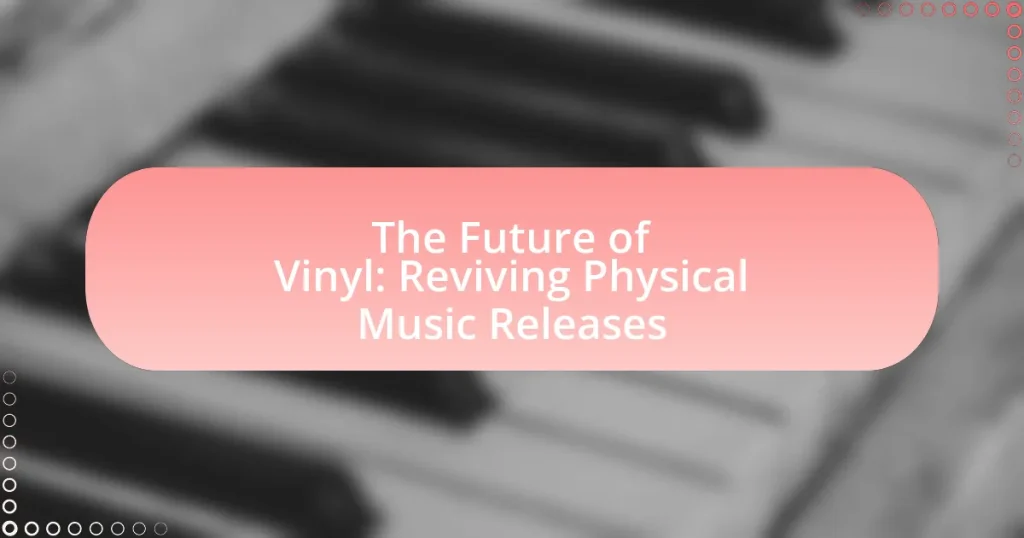The article examines the future of vinyl records and their significance in the music industry, highlighting a notable resurgence in popularity driven by consumer appreciation for analog sound quality and the tangible experience of physical media. Vinyl sales in the U.S. reached over 41 million units in 2022, marking the highest levels since the 1980s. The piece explores the evolution of the vinyl industry, historical factors influencing its rise and fall, and the impact of digital music on vinyl sales. It also discusses demographic trends, the role of collectors and audiophiles, and the challenges faced by the vinyl industry, including supply chain issues and environmental concerns. Additionally, the article outlines how consumers can engage with the vinyl revival and enhance their listening experience through best practices and quality equipment.

What is the Future of Vinyl and Its Significance in Music?
The future of vinyl is promising, as it continues to experience a resurgence in popularity among music enthusiasts and collectors. This revival is driven by a growing appreciation for the tangible experience of physical music formats, with vinyl sales reaching over 41 million units in the United States in 2022, marking the highest level since the 1980s. Vinyl’s significance in music lies in its unique sound quality, larger album artwork, and the nostalgic connection it fosters between artists and listeners. Additionally, the trend of limited edition releases and special pressings enhances its appeal, making vinyl not just a medium for music but also a collectible item.
How has the vinyl industry evolved over the years?
The vinyl industry has evolved significantly from its peak in the mid-20th century to a resurgence in the 21st century. Initially, vinyl records dominated the music market from the 1940s to the 1980s, with sales peaking in 1978 at over 340 million units in the U.S. However, the advent of cassette tapes and CDs led to a decline in vinyl sales, causing many pressing plants to close.
In the early 2000s, vinyl began to experience a revival, driven by a growing interest in analog sound quality and the tangible nature of physical media. By 2020, vinyl sales surpassed CD sales in the U.S. for the first time since the 1980s, with over 27 million vinyl records sold, according to the Recording Industry Association of America. This resurgence has led to the opening of new pressing plants and a wider variety of releases, including reissues and special editions, catering to both collectors and new listeners.
The evolution of the vinyl industry reflects changing consumer preferences, with a notable shift towards valuing physical music formats in an increasingly digital world.
What historical factors contributed to the rise and fall of vinyl records?
The rise of vinyl records was primarily driven by advancements in audio technology and the cultural significance of music in the mid-20th century. The introduction of the 33 1/3 RPM long-playing record in 1948 by Columbia Records allowed for longer playback times and improved sound quality, making vinyl the preferred medium for music consumption. Additionally, the post-World War II era saw a booming music industry, with vinyl records becoming a staple in households, further solidifying their popularity.
The fall of vinyl records began in the late 1970s and 1980s, largely due to the emergence of cassette tapes and later compact discs, which offered greater convenience and portability. The digital revolution in the 1990s, marked by the rise of MP3s and online music distribution, further diminished vinyl’s market share. By the early 2000s, vinyl sales had plummeted, with many manufacturers ceasing production altogether, reflecting a significant shift in consumer preferences towards digital formats.
However, recent years have seen a resurgence in vinyl’s popularity, driven by nostalgia, the tactile experience of physical media, and a renewed appreciation for analog sound quality, indicating a complex historical trajectory influenced by technological advancements and changing consumer behaviors.
How did digital music impact vinyl sales and production?
Digital music initially led to a decline in vinyl sales and production as consumers shifted towards more convenient and accessible formats. For instance, between 2000 and 2010, vinyl sales dropped significantly, with the Recording Industry Association of America reporting a decrease of over 90% in vinyl records sold. However, the resurgence of interest in vinyl began around 2008, driven by a desire for tangible music experiences and high-quality sound, which digital formats often lack. By 2020, vinyl sales surpassed CD sales in the U.S. for the first time since the 1980s, with over 27 million vinyl records sold, according to the Nielsen Music report. This revival has prompted record labels to increase vinyl production, leading to investments in pressing plants and new technologies to meet the growing demand.
Why is there a resurgence in vinyl popularity today?
The resurgence in vinyl popularity today is primarily driven by a growing appreciation for analog sound quality and the tangible nature of physical media. Many audiophiles and music enthusiasts believe that vinyl records provide a richer, warmer sound compared to digital formats, which has led to increased demand. According to the Recording Industry Association of America (RIAA), vinyl sales reached 41 million units in 2020, marking the highest sales figures since the 1980s. Additionally, the experience of collecting and owning physical records, along with the artwork and packaging, appeals to consumers seeking a more immersive and nostalgic connection to music. This trend is further supported by the rise of independent record stores and vinyl pressing plants, which cater to the growing market.
What demographic trends are driving the revival of vinyl records?
The revival of vinyl records is primarily driven by millennials and Gen Z consumers who seek tangible music experiences. These demographics value nostalgia and authenticity, often associating vinyl with a richer sound quality and a physical connection to music. According to a 2021 report from the Recording Industry Association of America (RIAA), vinyl sales reached their highest level since the 1980s, with millennials accounting for a significant portion of these purchases. Additionally, the trend is supported by the rise of independent record stores and vinyl-focused events, which cater to the interests of younger audiences looking for unique and collectible music formats.
How do collectors and audiophiles influence the vinyl market?
Collectors and audiophiles significantly influence the vinyl market by driving demand for high-quality pressings and limited editions. Their preferences for specific genres, artists, and sound quality lead to increased sales of vinyl records, which has been evidenced by the resurgence of vinyl sales, reaching over 41 million units in the U.S. in 2022, according to the Recording Industry Association of America. This demographic often prioritizes unique packaging, remastered audio, and collectible items, prompting record labels to produce special releases and reissues to cater to their interests. Consequently, the focus on quality and exclusivity in vinyl production is largely shaped by the desires and purchasing habits of collectors and audiophiles.
What role do physical music releases play in the current music landscape?
Physical music releases play a significant role in the current music landscape by serving as tangible collectibles that enhance the listener’s experience and foster a deeper connection to the music. In an era dominated by digital streaming, physical formats like vinyl and CDs have seen a resurgence, with vinyl sales reaching 41 million units in 2020, the highest level since 1991, according to the Recording Industry Association of America (RIAA). This revival is driven by consumers’ desire for authenticity, nostalgia, and the aesthetic appeal of physical artwork, which digital formats cannot replicate. Additionally, physical releases often include unique features such as limited editions, colored vinyl, and exclusive artwork, further incentivizing collectors and fans to purchase them.
How do physical releases compare to digital formats in terms of artist revenue?
Physical releases generally provide higher revenue per unit sold for artists compared to digital formats. For instance, artists typically earn around 10-20% of the retail price from physical sales, while digital platforms like streaming services often pay artists a fraction of a cent per stream, averaging about $0.004 per stream. This stark difference in revenue models highlights that while digital formats offer broader reach, physical releases can yield more substantial earnings for artists per sale. Additionally, the resurgence of vinyl sales, which have seen a 30% increase in revenue in recent years, underscores the potential for physical formats to enhance artist income in a predominantly digital landscape.
What are the emotional and experiential benefits of owning vinyl records?
Owning vinyl records provides significant emotional and experiential benefits, including a deeper connection to music and a sense of nostalgia. The tactile experience of handling vinyl, from the large album artwork to the act of placing the needle on the record, creates a more immersive listening experience compared to digital formats. This physical interaction fosters a stronger emotional bond with the music, as listeners often associate specific albums with personal memories or life events.
Research indicates that the analog sound quality of vinyl can evoke emotional responses, as the warmth and richness of the sound can enhance the listener’s enjoyment and connection to the music. Additionally, the ritualistic nature of playing vinyl records encourages mindfulness, allowing individuals to focus solely on the music without distractions, which can lead to a more fulfilling listening experience.

What are the Key Trends Shaping the Future of Vinyl?
Key trends shaping the future of vinyl include a resurgence in popularity driven by nostalgia, the rise of independent labels, and advancements in technology for production and distribution. The vinyl market has seen a significant increase in sales, with the Recording Industry Association of America reporting that vinyl sales surpassed CD sales in 2020 for the first time since the 1980s. Additionally, independent labels are increasingly releasing exclusive vinyl editions, catering to collectors and audiophiles. Technological improvements, such as high-quality pressing techniques and eco-friendly materials, are also enhancing the appeal of vinyl records, making them more sustainable and desirable for consumers.
How are artists and labels adapting to the vinyl revival?
Artists and labels are adapting to the vinyl revival by increasing their production of vinyl records and incorporating unique packaging and limited editions to attract collectors. In 2021, vinyl sales in the U.S. surpassed CD sales for the first time since the 1980s, indicating a significant market shift. This trend has prompted artists to release special editions, colored vinyl, and exclusive artwork, enhancing the physical appeal of their music. Additionally, many labels are investing in vinyl pressing plants to meet the growing demand, with the Recording Industry Association of America reporting a 61% increase in vinyl sales from 2020 to 2021. This strategic focus on vinyl not only caters to consumer nostalgia but also taps into the collectible nature of physical music formats.
What innovative marketing strategies are being used to promote vinyl releases?
Innovative marketing strategies used to promote vinyl releases include limited edition pressings, exclusive artwork, and bundled merchandise. These strategies create a sense of urgency and exclusivity, appealing to collectors and fans. For instance, artists often release colored vinyl or special packaging that enhances the aesthetic value, making the product more desirable. Additionally, leveraging social media platforms for targeted advertising and engaging storytelling about the album’s creation process helps to build a community around the release. According to a report by the Recording Industry Association of America, vinyl sales have seen a resurgence, with revenue reaching over $1 billion in 2022, indicating the effectiveness of these marketing strategies in driving consumer interest and sales.
How are collaborations between artists and vinyl manufacturers evolving?
Collaborations between artists and vinyl manufacturers are evolving towards more personalized and innovative production methods. Artists are increasingly seeking unique vinyl pressings that reflect their artistic vision, leading to the rise of custom packaging, colored vinyl, and limited editions. This trend is supported by the resurgence of vinyl sales, which reached 41 million units in the U.S. in 2022, indicating a strong consumer demand for physical music formats. Additionally, advancements in technology allow for shorter production runs and more intricate designs, enabling artists to experiment with their releases and engage fans in new ways.
What technological advancements are influencing vinyl production?
Technological advancements influencing vinyl production include improved cutting and pressing techniques, digital mastering, and automation in manufacturing processes. Enhanced cutting techniques, such as laser cutting, allow for greater precision and detail in the grooves, resulting in higher sound quality. Digital mastering enables sound engineers to optimize audio for vinyl, ensuring that the final product maintains fidelity to the original recording. Additionally, automation in pressing plants increases efficiency and reduces production time, allowing for quicker turnaround on vinyl releases. These advancements collectively contribute to a resurgence in vinyl’s popularity, with sales reaching over 41 million units in the U.S. in 2022, according to the Recording Industry Association of America.
How has modern technology improved the quality of vinyl records?
Modern technology has significantly improved the quality of vinyl records through advancements in manufacturing processes and digital mastering techniques. Innovations such as precision cutting lathes and high-resolution digital audio files allow for more accurate groove placement and better sound fidelity. For instance, the use of computer-controlled vinyl pressing machines ensures consistent quality and reduces defects, while digital mastering enables engineers to optimize audio for the unique characteristics of vinyl, resulting in clearer sound and enhanced dynamic range. These technological improvements have led to a resurgence in vinyl popularity, with sales reaching over 41 million units in the U.S. in 2022, the highest since the 1980s, demonstrating the impact of these advancements on consumer satisfaction and audio quality.
What new formats or features are being introduced in vinyl releases?
New formats and features being introduced in vinyl releases include colored vinyl, picture discs, and multi-disc sets. Colored vinyl offers aesthetic appeal and personalization, while picture discs feature artwork directly on the vinyl surface, enhancing visual presentation. Multi-disc sets allow for expanded content, such as additional tracks or remixes, catering to collectors and audiophiles. These innovations reflect the growing trend of vinyl as a collectible item, with sales reaching 41 million units in 2022, indicating a resurgence in popularity and demand for unique formats.
What challenges does the vinyl industry face moving forward?
The vinyl industry faces significant challenges moving forward, primarily including supply chain disruptions, rising production costs, and competition from digital formats. Supply chain disruptions have been exacerbated by global events, leading to delays in manufacturing and distribution. Rising production costs, particularly for raw materials like PVC, have increased the price of vinyl records, potentially limiting consumer demand. Additionally, competition from digital music platforms continues to pose a threat, as consumers increasingly favor convenience and accessibility over physical formats. These factors collectively hinder the vinyl industry’s growth and sustainability in an evolving music landscape.
How do supply chain issues affect vinyl production and availability?
Supply chain issues significantly disrupt vinyl production and availability by causing delays in raw material procurement and manufacturing processes. For instance, shortages of polyvinyl chloride (PVC), the primary material used in vinyl records, have been exacerbated by global logistics challenges and increased demand for physical media. According to the Recording Industry Association of America, vinyl sales reached a 30-year high in 2020, intensifying competition for limited resources. Consequently, these supply chain disruptions lead to longer wait times for production and reduced stock in retail outlets, ultimately affecting consumer access to vinyl records.
What environmental concerns are associated with vinyl manufacturing?
Vinyl manufacturing raises significant environmental concerns primarily due to the production process and materials used. The process involves the use of polyvinyl chloride (PVC), which is derived from fossil fuels and releases harmful chemicals during production, including dioxins and phthalates, both of which are toxic and can contaminate air and water sources. Additionally, the energy-intensive nature of vinyl production contributes to greenhouse gas emissions, exacerbating climate change. According to a study by the European Commission, the lifecycle of PVC, from production to disposal, poses risks to human health and the environment, highlighting the need for more sustainable practices in the vinyl industry.

How Can Consumers Engage with the Vinyl Revival?
Consumers can engage with the vinyl revival by purchasing vinyl records, attending record fairs, and supporting local record stores. The resurgence of vinyl sales, which reached 41 million units in the U.S. in 2022, indicates a strong consumer interest in physical music formats. Additionally, participating in community events and online forums dedicated to vinyl collecting fosters a sense of connection among enthusiasts, further driving the revival.
What are the best practices for starting a vinyl collection?
To start a vinyl collection effectively, focus on selecting a specific genre or artist that resonates with you. This targeted approach helps in building a cohesive collection and enhances your enjoyment of the music. Begin by researching reputable record stores or online platforms that specialize in vinyl, ensuring you purchase from trusted sources to avoid counterfeit records. Additionally, consider investing in quality equipment, such as a turntable and speakers, to fully appreciate the sound quality of vinyl. According to a 2021 report by the Recording Industry Association of America, vinyl sales reached a 30-year high, indicating a growing interest in physical music formats, which supports the idea of starting a collection now.
How can collectors identify valuable records in the market?
Collectors can identify valuable records in the market by researching the rarity, condition, and demand of specific albums. Rarity is often determined by limited pressings, special editions, or records from influential artists, such as The Beatles or Elvis Presley, which can significantly increase value. Condition is assessed using grading standards, where records in mint condition fetch higher prices. Demand can be gauged through auction results and sales data, indicating which records are sought after by collectors. For instance, a 1969 pressing of The Beatles’ “The White Album” with a low serial number recently sold for over $100,000, demonstrating how these factors contribute to a record’s value.
What resources are available for learning about vinyl care and maintenance?
Resources for learning about vinyl care and maintenance include books, online articles, instructional videos, and dedicated forums. Books such as “Vinyl: The Definitive Guide” provide comprehensive insights into vinyl care techniques. Online articles from reputable sources like Discogs and Vinyl Me, Please offer practical tips and best practices for maintaining vinyl records. Instructional videos on platforms like YouTube demonstrate cleaning methods and storage solutions. Additionally, forums such as Reddit’s r/vinyl community allow users to share experiences and advice, fostering a collaborative learning environment. These resources collectively equip vinyl enthusiasts with the knowledge needed to preserve their collections effectively.
How can music enthusiasts support the vinyl community?
Music enthusiasts can support the vinyl community by purchasing vinyl records from independent record stores and artists. This direct financial support helps sustain local businesses and promotes the production of new vinyl releases. According to the Recording Industry Association of America, vinyl sales reached 41 million units in 2020, indicating a growing demand that enthusiasts can further bolster by choosing to buy physical formats over digital ones. Additionally, attending vinyl fairs and participating in community events fosters a sense of connection and encourages the sharing of music culture, which is vital for the community’s growth.
What local events or record fairs should collectors attend?
Collectors should attend local record fairs such as the Brooklyn Vinyl Record Fair in New York, the Los Angeles Record Fair, and the Chicago Vinyl Record Show. These events are known for their extensive selection of vinyl records, attracting both collectors and vendors. For instance, the Brooklyn Vinyl Record Fair features hundreds of vendors and thousands of records, making it a prime destination for collectors seeking rare finds. The Los Angeles Record Fair, held multiple times a year, showcases a diverse array of genres and offers opportunities for collectors to network with other enthusiasts. The Chicago Vinyl Record Show is recognized for its large turnout and variety of records, providing a vibrant marketplace for collectors.
How can consumers promote independent artists through vinyl purchases?
Consumers can promote independent artists through vinyl purchases by directly supporting their music sales, which often provide higher profit margins compared to digital formats. When consumers buy vinyl records, they contribute to the artist’s revenue, enabling them to fund future projects and sustain their careers. According to a report by the Recording Industry Association of America (RIAA), vinyl sales have seen a resurgence, with revenue reaching over $1 billion in 2020, indicating a growing market that favors independent artists who often rely on physical sales for financial stability. Additionally, purchasing vinyl can help increase an artist’s visibility, as unique album artwork and physical formats often attract attention and encourage sharing among fans.
What tips can enhance the vinyl listening experience?
To enhance the vinyl listening experience, ensure proper setup and maintenance of your turntable. A well-calibrated turntable with the correct tracking force and anti-skate settings minimizes distortion and wear on the vinyl. Additionally, using a high-quality stylus and regularly cleaning both the records and the stylus can significantly improve sound quality. Research indicates that dust and debris can cause pops and clicks, detracting from the listening experience. Furthermore, investing in a good quality amplifier and speakers tailored for vinyl playback can enhance audio fidelity, allowing for a richer and more immersive sound.
How does the choice of turntable affect sound quality?
The choice of turntable significantly affects sound quality by influencing factors such as tracking accuracy, vibration isolation, and cartridge compatibility. High-quality turntables typically feature better build materials and engineering, which reduce unwanted resonance and distortion, leading to clearer sound reproduction. For instance, a turntable with a heavy platter minimizes speed fluctuations, while a well-designed tonearm ensures precise tracking of the record grooves. Studies have shown that turntables with superior components can enhance audio fidelity, making the listening experience more enjoyable and true to the original recording.
What accessories can improve the overall enjoyment of vinyl records?
High-quality accessories that can improve the overall enjoyment of vinyl records include a good turntable, a quality cartridge, and a record cleaning kit. A good turntable, such as those from brands like Rega or Pro-Ject, ensures accurate playback and minimizes distortion. A quality cartridge, like the Ortofon 2M series, enhances sound clarity and detail. Additionally, a record cleaning kit, which often includes a brush and cleaning solution, helps maintain the vinyl’s surface, reducing noise and preserving sound quality. These accessories collectively enhance the listening experience by ensuring optimal playback conditions and maintaining the integrity of the records.


